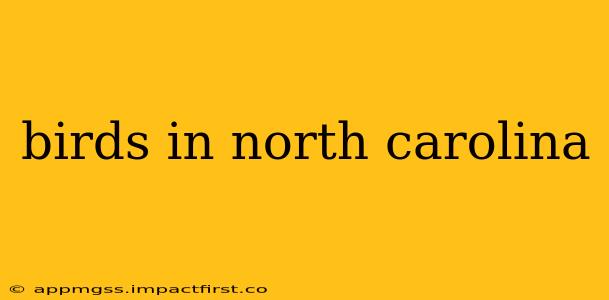North Carolina, with its diverse habitats ranging from the Blue Ridge Mountains to the coastal plains, boasts a rich and vibrant birdlife. From majestic bald eagles soaring overhead to tiny hummingbirds flitting amongst wildflowers, the Tar Heel State offers incredible opportunities for birdwatching enthusiasts of all levels. This guide explores the diverse avian species found in North Carolina, covering common birds, unique regional variations, and tips for enhancing your birdwatching experiences.
What are some common birds in North Carolina?
North Carolina's varied landscapes support a vast array of bird species. Some of the most commonly sighted birds include:
- Northern Cardinal: This vibrant red bird is a year-round resident and a familiar sight in backyards across the state. Their cheerful song is unmistakable.
- American Robin: Another ubiquitous bird, the American Robin is known for its reddish-orange breast and melodious call. They're often seen foraging on lawns.
- Blue Jay: With their striking blue plumage and boisterous calls, Blue Jays are easily recognizable. They are known for their intelligence and adaptability.
- Downy Woodpecker: This small woodpecker is a common visitor to backyard bird feeders, where it enjoys sunflower seeds and suet.
- House Sparrow: While not native, the House Sparrow is a highly adaptable and widespread bird found in urban and suburban areas throughout North Carolina.
What are some of the best places to birdwatch in North Carolina?
North Carolina offers numerous exceptional locations for birdwatching, catering to different preferences and skill levels. Some notable spots include:
- The Great Smoky Mountains National Park: This park boasts a high biodiversity, offering chances to spot various warblers, woodpeckers, and raptors.
- Cape Hatteras National Seashore: This coastal area is a haven for migrating shorebirds and seabirds, including various gulls, terns, and pelicans.
- Pea Island National Wildlife Refuge: Known for its diverse wetland habitats, this refuge attracts a wide range of waterfowl, wading birds, and shorebirds.
- Lake Norman: This large lake provides excellent opportunities for observing waterfowl, herons, and other water-associated birds.
- Uwharrie National Forest: This forested area offers habitats suitable for various woodland birds, including woodpeckers, owls, and warblers.
What birds migrate through North Carolina?
North Carolina serves as a crucial stopover point for numerous migratory bird species. During spring and fall migrations, the state sees a dramatic increase in bird diversity. Many warblers, vireos, tanagers, and flycatchers pass through on their journeys between their breeding and wintering grounds. The timing of migration varies depending on the species and weather conditions.
What are some rare birds found in North Carolina?
While many common birds are easily spotted, North Carolina occasionally hosts rarer visitors. These sightings are often exciting events for birders. Keep an eye out for species like the Kirtland's Warbler (extremely rare), the Piping Plover (endangered), and various owl species depending on the season and location. Reliable birdwatching resources and local birding communities can help you stay updated on rare bird sightings.
How can I attract birds to my backyard in North Carolina?
Creating a bird-friendly backyard in North Carolina involves providing the essential elements that birds need to thrive. This includes:
- Food sources: Offering a variety of birdseed, suet, and fruit will attract a wider range of species.
- Water sources: A birdbath provides a vital source of drinking water and bathing opportunities.
- Shelter: Planting native trees, shrubs, and dense vegetation offers protection from predators and inclement weather.
- Nesting sites: Providing nesting boxes tailored to different bird species can encourage nesting in your backyard.
What are the best times of year for birdwatching in North Carolina?
Spring and fall migrations are prime times for birdwatching in North Carolina, as many species pass through during these periods. However, winter and summer also offer unique opportunities to observe resident species and their breeding behaviors. The best time ultimately depends on the specific birds you're hoping to see.
What resources are available for identifying birds in North Carolina?
Numerous resources are available to help you identify birds in North Carolina. These include:
- Field guides: Comprehensive field guides featuring detailed illustrations and descriptions of North Carolina birds are essential for identification.
- Online resources: Websites and apps such as eBird and Merlin Bird ID offer valuable tools for bird identification, location tracking, and community sharing of sightings.
- Local birding clubs: Joining a local birding club provides opportunities to connect with experienced birders, participate in guided walks, and learn more about the local avifauna.
By utilizing these resources and venturing into the diverse landscapes of North Carolina, you can embark on a rewarding journey of discovery and appreciation for the rich avian tapestry of the Tar Heel State. Happy birding!
